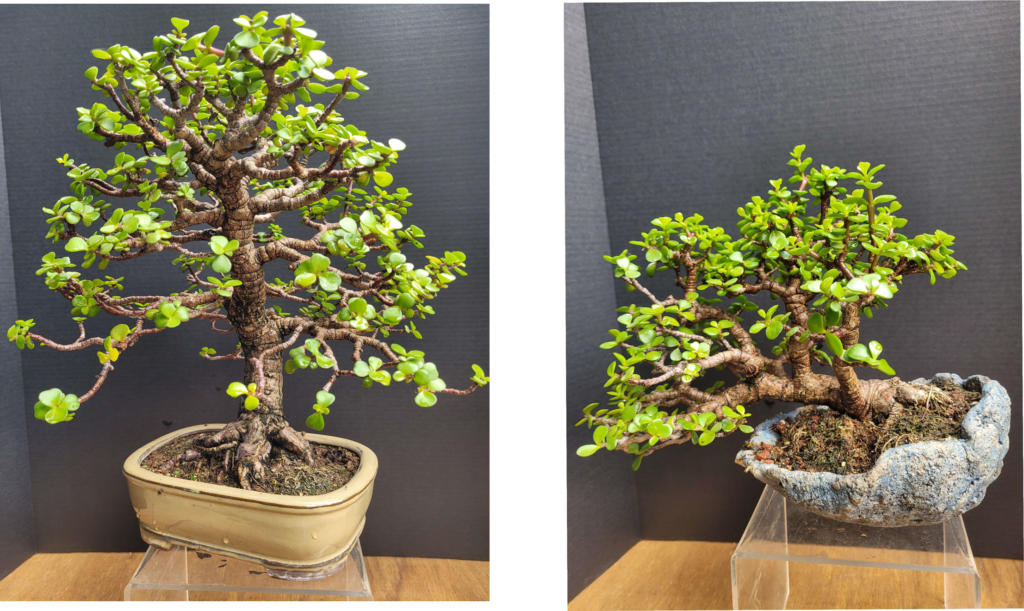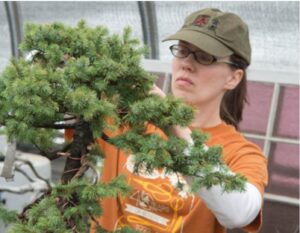Portulacaria afra
The Portulacaria afra, commonly known as the Dwarf Jade or Elephant Bush, is a succulent species that thrives as a bonsai. Its resilience, low maintenance requirements, and appealing appearance make it an excellent choice for beginners and experienced enthusiasts alike. Though similar in appearance, it is not related to the Jade Plant. Unlike Jade plants which are toxic the Dwarf Jade is completely safe. It is native to South Africa. The two most common varieties for bonsai are the green leaf type and the variegated type. The color of its bark changes from green (when the tree is young) to reddish-brown (when the tree reaches its maturity) to grayish (when the tree is older). As a bonsai it can have a lifespan of up to 200 years and beyond.

FUN FACTS: It is a favorite food source of African elephants and tortoises! In some countries in southern Africa, elephant bush leaves are used in salads and soups to add a sour flavor and juicy crunch.
It is an excellent “carbon sponge”. It is so efficient at absorbing carbon that it can remove more carbon than an equal amount of deciduous trees.
PLACEMENT: The Dwarf Jade can thrive indoors near bright windows and flourishes when allowed outdoors during the warm months. Avoid freezing temperatures. If put outside it must be brought indoors when temps are reaching 50F. The development of red edges on the leaves is a good indicator that the tree is receiving sufficient sunlight.
WATERING: Yellow leaves on the Dwarf Jade are usually due to overwatering. Roots that sit in soggy soil can’t absorb nutrients to feed the tree. Overwatering can lead to root rot. The yellowing leaves eventually die. Allow the soil to dry out between watering sessions. The Portulacaria afra bonsai is a succulent, meaning it stores water in its leaves and stems. It prefers infrequent but deep watering sessions. Dwarf Jade bonsai prefer well-draining soil. Shriveling leaves on a dwarf jade is an indicator it needs water. Also a rule of thumb is to wait until you see shriveling leaves before pruning, styling or repotting. If you plan to re-pot or prune, stop watering and don’t start watering again until new leaves emerge on their own.
FERTILIZING: Jades love higher nitrogen fertilizer. During the growing season, which typically spans from spring to early autumn, fertilize your bonsai with a balanced fertilizer every two to four weeks. Reduce or stop fertilizing during the dormant winter months.
PRUNING AND STYLING: The most suitable bonsai styles are the semi-cascade, cascade, informal upright and groups/forests. Since this is a succulent, it droops from its weight because of the water contained in its trunk and branches. As a result, it is a good candidate for long cascades.
Shaping of the Portulacaria afra bonsai using wire can be a challenging task, since the wire easily cuts into the trunk and branches and damages them. It is best to opt out of wiring. Or if you do use wire, you must check frequently and remove it when you see signs of the wire cutting into the bark. This bonsai, especially when mature, needs to be pinched regularly during the growing season. Regular and even drastic pruning is a good alternative to wiring, especially since Portulacaria afra is a fast growing tree. The tree readily produces buds wherever branches or even leaves are removed, so it is easily kept almost any size or shape just by pinching or cutting just above a pair of leaves. When removing a branch it is safer to always leave a small stub which will, in time, either rub off or fall off. Use of cut paste is not required, since this plant calluses over naturally. Removal of large branches or parts of the roots needs to be done only when the soil is dry. These branches are extremely pliable when the plant is allowed to dry out before any major work is done. It’s important to keep your freshly pruned/styled dwarf jades under cover where they still get bright light but no water. After signs of new growth they can be put back into full sun. Avoid heavy pruning during the dormant winter period.
RE-POTTING: Portulacaria afra bonsai are best re-potted in spring, every two to three years or when the roots have filled the entire pot. More mature specimens need to be re-potted once every four to five years. Before re-potting, the soil needs to be completely dry. Not more than a third of the root mass should be removed. Once the tree has been placed in its new pot it should not be watered before new growth begins. No fertilizer should be applied for at least a month after the tree has been re-potted. Once it starts to grow, it can be placed into full sun and watered for the first time.
PROPAGATION: Propagation of the Portulacaria afra bonsai is extremely easy and can be done through stem cuttings. Take a healthy cutting, allow it to dry for a few days, then plant it in a well-draining soil mix. Keep the soil lightly moist until roots establish.
INSECTS/ PESTS/ DISEASES: The most common disease to affect the Dwarf Jade is root rot. This fungal disease is caused by over watering and is easy to avoid if you water your tree properly. As a rule, only water your Portulacaria afra when the soil is dry. Mealybugs and Aphids tend to emerge during warmer and more humid months, particularly when conditions are damp. They primarily target the tender new growth that emerges in spring.
Written by: Charlotte Field



